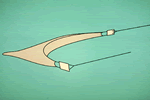A fishing gear is the tool with which aquatic resources are captured, whereas the fishing method is how the gear is used. Gear also includes harvesting organisms when no particular gear (tool) is involved. Furthermore, the same fishing gear can be used in different ways. A common way to classify fishing gear and methods is based on the principles of how the fish or other prey are captured and, to a lesser extent, on the gear construction.
The FAO defines and classifies the main categories of fishing gear as follows:
- Bottom trawl nets (includes beam; otter and pair trawls).
- Midwater trawl nets (includes otter and pair trawls).
- Surrounding nets (includes purse seines).
- Seine nets (includes beach seines; boat; Scottish/Danish seines).
- Dredges.
- Lift nets.
- Falling gears (includes cast nets).
- Gillnets and entangling nets (includes set and drifting gillnets; trammel nets)
- Traps (includes pots, stow or bag nets; fixed traps)
- Hooks and lines (includes handlines; pole and lines; set or drifting longlines; trolling lines)
- Grappling and wounding gears (includes harpoons, spears, arrows, etc).
- Stupefying devices.
 Trawling
Trawling
Trawling is the most common commercial fishing method used in New Zealand waters. It is generally used for deep-water fisheries like orange roughy, hoki, ling, hake and squid. A fishing boat tows a large net behind it, sometimes in the middle of the water, and sometimes on the sea floor. Sometimes two fishing boats might tow a big net together.
 Seining
Seining
Seining (pron: “sayning”) involves dropping a net to surround and trap a school of fish. There are two types of seining – Danish seining, which is used to catch fish near the bottom of the sea, and purse seining, which is used to catch fish near the surface.
Dredging
Dredging is used to gather scallops and oysters from shallow water. A fishing boat tows a steel net (dredge) along the sea floor, and the net scrapes up all the shellfish living there.
Line fishing
The most common line fishing methods are hand-lines and long-lines.
Hand-lines are mainly used by recreational fishers. A hand-line is a single fishing line, usually attached to a rod, and held by hand.
Long-lines have a main fishing line, with lots of shorter lines hanging off it. The shorter lines have bait and hooks attached to them. The main line is anchored at each end, and floats stop the line from sinking.
Line fishing doesn’t bruise or damage the fish as much as net fishing, but you can’t catch as many fish as quickly on a line as you can in a net.
 Netting
Netting
There are many kinds of fishing nets, but usually they are long, narrow and flat with weights at the bottom edge and floats at the top so that the net hangs down into the sea like a wall, and fish swim into it and get caught in its mesh.
The most common type of netting used by recreational fishers is set netting. Commercial fishers also use set netting to catch some types of fish, like flounder and butterfish. Set netting involves setting a net halfway down or near the bottom of the sea, and leaving it there for fish to swim into.
 Potting
Potting
A pot-like trap that is attached to a long rope is baited with fish and dropped from a fishing boat. The rope is marked with floats so that the fisher can easily find the line when they want to haul up the pot again. Potting is used to catch rock lobster and blue cod.
Diving
 Some commercial and recreational fishers dive for paua, scallops, and rock lobster. You are only allowed to go snorkelling for paua (not scuba diving)
Some commercial and recreational fishers dive for paua, scallops, and rock lobster. You are only allowed to go snorkelling for paua (not scuba diving)
There are many different ways to catch a fish, and before you go fishing, you should decide what kind of fishing you want to do. Some of the things you need to think about are:
- Where you want to fish, and if there are any closed areas there.
- What kind of fish you want to catch.
- What the rules are for catching that kind of fish.
- The weather and sea conditions.
- The type of boat and/or gear that you will need.
It should be noted that with many fishing methods there are associated environmental impacts and issues. To find out more about these
click here.